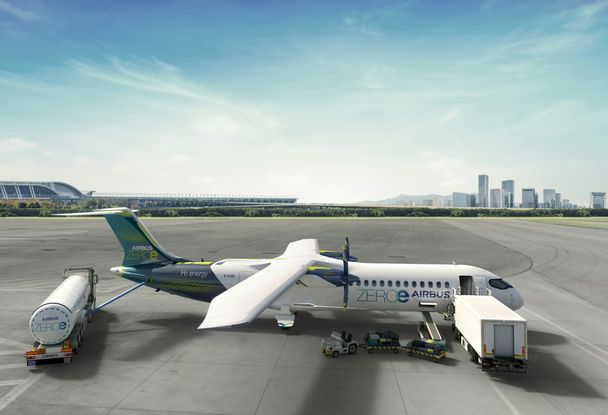HIA Milestone Delivery Report lists critical next steps for UK to be leader in global hydrogen aviation race

- The Hydrogen in Aviation alliance is calling for a comprehensive industrial strategy for aviation to ensure the UK is a global leader in the development of hydrogen aviation
- The report sets out how to ensure the country has the right conditions for the technological development, regulation, infrastructure, financial framework and hydrogen supply that will be needed for hydrogen aviation
- HIA's ultimate goal is to ensure hydrogen-powered flights become a reality to help preserve the huge social and economic benefits that aviation brings
- The Alliance, formed of major players across the aviation, manufacturing and renewable energy sectors, see hydrogen as one of the key tools for the decarbonisation of aviation, and key to creating new jobs and supporting the sector's long term sustainable future
The Hydrogen in Aviation alliance (HIA), formed of easyJet, Rolls-Royce, Airbus, Ørsted, GKN Aerospace, Bristol Airport and ZeroAvia, has today released its Milestone Delivery Report – outlining the steps and timeline the UK Government and industry needs to follow to secure its position as a global leader in hydrogen-powered aviation.
The UK is home to many world-first advances in hydrogen-powered aircraft technology, from hydrogen engine testing to the first flights of hydrogen-fuelled planes – making it well placed to be a leader in hydrogen aviation. This would secure substantial economic, employment and sustainability benefits. To realise these benefits we need an industrial strategy for the sector focussed on these long term opportunities.
The UK will need to secure massive increases in hydrogen supply. This will involve the accelerated deployment of renewable energy generation and significant investment in hydrogen infrastructure and skills.
In order to achieve this, HIA's new Milestone Delivery Report – which has been shaped by accurate aviation demand figures and other critical industry data – outlines specific steps that need to be taken by industry, government and regulators to equip the UK with everything it needs to be a leader in the field of hydrogen-powered aviation.
Johan Lundgren, CEO of easyJet and first Chair of HIA, said:
“It's without doubt that the UK is well placed to be a global leader in hydrogen – but the opportunity will be gone if we do not act now to build on all the great work that has already been done.
“The breakthroughs in hydrogen-powered technology happening across the UK are truly astonishing but these advances will be inconsequential if we fail to complement them with the appropriate skills, infrastructure, investment and regulation needed to support hydrogen aviation.
“HIA's Milestone Delivery Report outlines the critical steps and the timeframe needed to do this and if followed, not only will it create significant wealth, jobs and prosperity across industry and across the UK, it will be a vital component in decarbonising the aviation sector.”
Mark Bentall, Head of Research & Technology at Airbus, said:
“Technology is already unlocking the potential of hydrogen as a new fuel and Airbus is firmly focused on getting a hydrogen powered aircraft in the air by 2035. Beyond the aircraft, we have to prepare people, policy and infrastructure to build a world-leading hydrogen aviation economy in the UK. This report gives us the blueprint for making it happen, so now is the time to follow through.”
Dave Lees, CEO of Bristol Airport, said:
“Having hydrogen refuelling infrastructure at airports, operated by a skilled workforce, is critical to the success of zero emissions flight. Leaders such as Bristol Airport stand ready to work with industry, government, and regulators to begin the first commercial hydrogen flights within this decade. We can play our part to support the UK to seize the economic and social opportunities of zero emission flight.”
Russ Dunn, CTO of GKN Aerospace, said:
“This report sets the direction for a very exciting carbon-free future of flight. At GKN Aerospace we are committed to making this a reality through our world-leading technology and partnerships across industry, academia and government. The UK now needs to commit to this at a national level - to truly coordinate efforts and seize the opportunity that is in front of us. Now is the time to prepare for and enable the huge sustainability and economic potential of hydrogen for both the aviation industry and wider economy.”
Robert Duncalf, Head of Commercial P2X at Ørsted, said:
“Across a number of sectors, including aviation, de-fossilisation will only be achieved through innovation and focussed investment from industry and government. The potential for use of green hydrogen produced through renewable energy in the sector is clear, but there are many challenges ahead. What we need to see now is further collaborative action to ensure sustained momentum to overcome these challenges and take the UK hydrogen journey to the next stage.”
Alan Newby, Director of Research and Technology, Rolls-Royce, said:
“We believe in the potential of hydrogen-powered flight, and we are making good progress in developing the key technology building blocks required to make it a reality. This is an ambitious but necessary challenge, and we look forward to further accelerating progress across the entire hydrogen ecosystem with our industry partners and the UK government to achieve our shared vision of a more sustainable future for aviation.”
Sergey Kiselev, Chief Business Officer, ZeroAvia said:
“This report is a real testament to cross-industry efforts to set a practical pathway to adopting hydrogen as the fuel of the future for aviation. Hydrogen-powered aircraft will be flying commercially in the UK within the next few years, meaning that there will be a clear roadmap needed to scale the fuel supply as it grows into larger aircraft segments. Hydrogen in Aviation is a powerful coalition for driving this change in partnership with with the Government.”
The six key recommendations outlined by HIA in its milestone delivery report, include:
- Hydrogen-ready technology research and development: HIA recommends that measures are taken to support the transition from research to development, and ultimately industrialisation, of world leading propulsion and flight technologies in the UK.
See more information in Chapter 1 of HIA's milestone delivery report (p.9 onwards) - A hydrogen-ready CAA: HIA recommends that the CAA is appropriately resourced and funded with the capacity to lead on certification, standard-setting, and new regulation – working in co-ordination with other relevant bodies and the academic community to support a hydrogen-ready future.
See more information in Chapter 1 of HIA's milestone delivery report (pp. 13-14) - Hydrogen-ready airports: HIA recommends building a well-developed network of hydrogen-ready airports both in the UK and overseas.
See more information on this section in Chapter 3 of HIA's milestone delivery report (p. 23 onwards) - Transition fund and incentives: HIA recommends the government provide the necessary support and incentives needed to get the sector over the hurdle of transition costs and investment in new infrastructure.
See more information on this section in Chapter 4 of HIA's milestone delivery report (p. 29 onwards) - Plan to deliver aviation's hydrogen requirements: Given the significant rise in demand for hydrogen that's expected over the next several decades, HIA recommends scaling up both hydrogen production capacity as well as renewable power, carbon capture and low carbon hydrogen generation to ensure the UK can secure sufficient hydrogen for all sectors that need to decarbonise, including aviation.
See more information on this section in Chapter 2 of HIA's milestone delivery report (p. 17 onwards) - A hydrogen-ready skillforce: HIA recommends government and industry work together to equip the UK's workforce with the appropriate skills and ensure industry-readiness to support the transition to this new technology.
See more information on this section in Chapter 1 (p. 14) and Chapter 4 (pp. 35-37) of HIA's milestone delivery report
Delivering net zero, securing and creating jobs for the future:
The aviation sector is incredibly valuable to the UK's economy, bringing in more than £22bn directly to GDP, plus £34bn from exporting aerospace components. It also directly employs over 230,000 people.
HIA believes hydrogen will be critical in securing these jobs into the future as zero-emission technology develops, and this will bring immense value to regions all over the UK.
East Midlands Hydrogen, the UK's largest inland hydrogen cluster estimates its future hydrogen network could support up to 110,000 jobs in just the East Midlands alone – showing the potential that hydrogen has in terms of job creation.
As well as preserving an industry that is a key part of our economy, HIA maintains hydrogen could generate an additional £34bn for the UK every year.
Your contact
Victoria Grayling
AIRBUS | Commercial Aircraft



